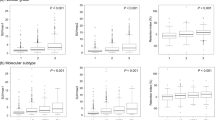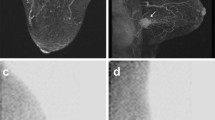Abstract
Purpose
Monitoring of response to neoadjuvant chemotherapy (NCT) is important for optimal management of patients with breast cancer. 99mTc-3PRGD2 SPECT is a newly developed imaging modality for evaluating tumor vascular status. In this study, we investigated the application of 99mTc-3PRGD2 SPECT in evaluating therapy response to NCT in patients with stage II or III breast cancer.
Methods
Thirty-three patients were scheduled to undergo 99mTc-3PRGD2 SPECT at baseline, after the first and second cycle of NCT. Four patients had extremely low 99mTc-3PRGD2 uptake at baseline, and were not included in the subsequent studies. Changes in tumor to nontumor (T/N) ratio were compared with pathological tumor responses classified using the residual cancer burden system. Receiver operator characteristic analysis was used to compare the power to identify responders between the end of the first and the end of the second cycle of NCT. The impact of breast cancer subtype on 99mTc-3PRGD2 uptake was evaluated. The correlation between 99mTc-3PRGD2 uptake and pathological tumor response was also evaluated in each breast cancer subtype.
Results
Surgery was performed after four cycles of NCT and pathological analysis revealed 18 responders and 15 nonresponders. In patients with clearly visible 99mTc-3PRGD2 uptake at baseline, the sensitivity, specificity, and negative predictive value of 99mTc-3PRGD2 SPECT were 86.7 %, 85.7 % and 86.7 % after the first cycle of NCT, and 92.9 %, 93.3 % and 93.3 % after the second cycle, respectively. Among these patients, the HER-2-positive group demonstrated both higher T/N ratios and a greater change in T/N ratio than patients with other breast cancer subtypes (P < 0.05). A strong correlation was found between changes in T/N ratio and pathological tumor response in the HER-2-positive group (P < 0.03).
Conclusion
99mTc-3PRGD2 SPECT seems to be useful for determining the pathological tumor response in patients with stage II or III breast cancer undergoing NCT, especially those with the HER-2-positive subtype.




Similar content being viewed by others
Reference
Fisher B, Bryant J, Wolmark N, Mamounas E, Brown A, Fisher ER, et al. Effect of preoperative chemotherapy on the outcome of women with operable breast cancer. J Clin Oncol. 1998;16(8):2672–85.
van der Hage JA, van de Velde CJ, Julien JP, Tubiana-Hulin M, Vandervelden C, Duchateau L. Preoperative chemotherapy in primary operable breast cancer: results from the European Organization for Research and Treatment of Cancer trial 10902. J Clin Oncol. 2001;19(22):4224–37.
Ollivier L, Balu-Maestro C, Leclere J. Imaging in evaluation of response to neoadjuvant breast cancer treatment. Cancer Imaging. 2005;5:27–31.
Kolesnikov-Gauthier H, Vanlemments L, Baranzelli MC, Vennin P, Servent V, Fournier C, et al. Predictive value of neoadjuvant chemotherapy failure in breast cancer using FDG-PET after the first course. Breast Cancer Res Treat. 2012;131:517–25.
Humbert O, Berriolo-Riedinger A, Riedinger JM, Coudert B, Arnould L, Cochet A, et al. Changes in 18F-FDG tumor metabolism after a first course of neoadjuvant chemotherapy in breast cancer: influence of tumor subtypes. Ann Oncol. 2012;23:2572–7.
Schwarz-Dose J, Untch M, Tiling R, Sassen S, Mahner S, Kahlert S, et al. Monitoring primary systemic therapy of large and locally advanced breast cancer by using sequential positron emission tomography imaging with [18F]fluorodeoxyglucose. J Clin Oncol. 2009;27(4):535–41.
Koolen BB, Pengel KE, Wesseling J, Vogel WV, Vrancken Peeters MJ, Vincent AD, et al. Sequential 18F-FDG PET/CT for early prediction of complete pathological response in breast and axilla during neoadjuvant chemotherapy. Eur J Nucl Med Mol Imaging. 2014;41:32–40.
Martincich L, Montemurro F, De Rosa G, Marra V, Ponzone R, Cirillo S, et al. Monitoring response to primary chemotherapy in breast cancer using dynamic contrast-enhanced magnetic resonance imaging. Breast Cancer Res Treat. 2004;83(1):67–76.
Woodhams R, Kakita S, Hata H, Iwabuchi K, Kuranami M, Gautam S, et al. Identification of residual breast carcinoma following neoadjuvant chemotherapy: diffusion-weighted imaging – comparison with contrast-enhanced MR imaging and pathologic findings. Radiology. 2010;254(2):357–66.
Meisamy S, Bolan PJ, Baker EH, Bliss RL, Gulbahce E, Everson LI, et al. Neoadjuvant chemotherapy of locally advanced breast cancer: predicting response with in vivo (1)H MR spectroscopy – a pilot study at 4 T. Radiology. 2004;233(2):424–31.
Wahner-Roedler DL, Boughey JC, Hruska CB, Chen B, Rhodes DJ, Tortorelli CL, et al. The use of molecular breast imaging to assess response in women undergoing neoadjuvant therapy for breat cancer: a pilot study. Clin Nucl Med. 2012;37(4):344–50.
Mitchell D, Hruska CB, Boughey JC, Wahner-Roedler DL, Jones KN, Tortorelli CL, et al. 99mTc-Sestamibi using a direct conversion molecular breast imaging system to assess tumor response to neoadjuvant chemotherapy in women with locally advanced breast cancer. Clin Nucl Med. 2013;38:949–56.
Niu G, Chen X. Why integrin as a primary target for imaging and therapy. Theranostics. 2011;1:30–47.
Ma Q, Ji B, Jia B, Gao S, Ji T, Wang X, et al. Differential diagnosis of solitary pulmonary nodules using 99mTc-3P(4)-RGD(2) scintigraphy. Eur J Nucl Med Mol Imaging. 2011;38(12):2145–52.
Ma Q, Chen B, Gao S, Ji T, Wen Q, Song Y, et al. 99mTc-3P4-RGD2 scintimammography in the assessment of breast lesions: comparative study with 99mTc-MIBI. PLoS One. 2014;9(9), e108349.
Liu L, Song Y, Gao S, Ji T, Zhang H, Ji B, et al. (99)mTc-3PRGD2 scintimammography in palpable and nonpalpable breast lesions. Mol Imaging. 2014;13:1535–3508.
Zhu Z, Miao W, Li Q, Dai H, Ma Q, Wang F, et al. 99mTc-3PRGD2 for integrin receptor imaging of lung cancer: a multicenter study. J Nucl Med. 2012;53(5):716–22.
Ji S, Zheng Y, Shao G, Zhou Y, Liu S. Integrin alpha(v)beta(3)-targeted radiotracer (99m)Tc-3P-RGD(2) useful for noninvasive monitoring of breast tumor response to antiangiogenic linifanib therapy but not anti-integrin alpha(v)beta(3) RGD(2) therapy. Theranostics. 2013;3(11):816–30.
Ji S, Zhou Y, Voorbach MJ, Shao G, Zhang Y, Fox GB, et al. Monitoring tumor response to linifanib therapy with SPECT/CT using the integrin alphavbeta3-targeted radiotracer 99mTc-3P-RGD2. J Pharmacol Exp Ther. 2013;346(2):251–8.
Sobin LH, Gospodarowicz M, Wittekind C. TNM classification of malignant tumours, 7 ed. New York: Wiley; 2011.
Symmans WF, Peintinger F, Hatzis C, Rajan R, Kuerer H, Valero V, et al. Measurement of residual breast cancer burden to predict survival after neoadjuvant chemotherapy. J Clin Oncol. 2007;25(28):4414–22.
Gasparini G. Prognostic value of vascular endothelial growth factor in breast cancer. Oncologist. 2000;5 Suppl 1:37–44.
Nieto Y, Woods J, Nawaz F, Baron A, Jones RB, Shpall EJ, et al. Prognostic analysis of tumor angiogenesis, determined by microvessel density and expression of vascular endothelial growth factor, in high-risk primary breast cancer patients treated with high-dose chemotherapy. Br J Cancer. 2007;97(3):391–7.
Tas F, Yavuz E, Aydiner A, Saip P, Disci R, Iplikci A, et al. Angiogenesis and p53 protein expression in breast cancer: prognostic roles and interrelationships. Am J Clin Oncol. 2000;23(6):546–53.
Viens P, Jacquemier J, Bardou VJ, Bertucci F, Penault-LIorca F, Puig B, et al. Association of angiogenesis and poor prognosis in node-positive patients receiving anthracycline-based adjuvant chemotherapy. Breast Cancer Res Treat. 1999;54(3):205–12.
Zhao D, Jin X, Li F, Liang J, Lin Y. Integrin alphavbeta3 imaging of radioactive iodine-refractory thyroid cancer using 99mTc-3PRGD2. J Nucl Med. 2012;53(12):1872–7.
Nahleh Z, Sivasubramaniam D, Dhaliwal S, Sundarajan V, Komrokji R. Residual cancer burden in locally advanced breast cancer: a superior tool. Curr Oncol. 2008;15(6):271–8.
Lee SM, Bae SK, Kim TH, Yoon HK, Jung SJ, Park JS, et al. Value of 18F-FDG PET/CT for early prediction of pathologic response (by residual cancer burden criteria) of locally advanced breast cancer to neoadjuvant chemotherapy. Clin Nucl Med. 2014;39(10):882–6.
Hylton NM, Blume JD, Bernreuter WK, Pisano ED, Rosen MA, Morris EA, et al. Locally advanced breast cancer: MR imaging for prediction of response to neoadjuvant chemotherapy – results from ACRIN 6657/I-SPY TRIAL. Radiology. 2012;263(3):663–72.
Laughner E, Taghavi P, Chiles K, Mahon PC, Semenza GL. HER2 (neu) signaling increases the rate of hypoxia-inducible factor 1alpha (HIF-1alpha) synthesis: novel mechanism for HIF-1-mediated vascular endothelial growth factor expression. Mol Cell Biol. 2001;21(12):3995–4004.
Blackwell KL, Dewhirst MW, Liotcheva V, Snyder S, Broadwater G, Bentley R, et al. HER-2 gene amplification correlates with higher levels of angiogenesis and lower levels of hypoxia in primary breast tumors. Clin Cancer Res. 2004;10(12 Pt 1):4083–8.
Konecny GE, Meng YG, Untch M, Wang HJ, Bauerfeind I, Epstein M, et al. Association between HER-2/neu and vascular endothelial growth factor expression predicts clinical outcome in primary breast cancer patients. Clin Cancer Res. 2004;10(5):1706–16.
Klos KS, Wyszomierski SL, Sun M, Tan M, Zhou X, Li P, et al. ErbB2 increases vascular endothelial growth factor protein synthesis via activation of mammalian target of rapamycin/p70S6K leading to increased angiogenesis and spontaneous metastasis of human breast cancer cells. Cancer Res. 2006;66(4):2028–37.
Izumi Y, Xu L, di Tomaso E, Fukumura D, Jain RK. Tumour biology: herceptin acts as an anti-angiogenic cocktail. Nature. 2002;416(6878):279–80.
Spiridon CI, Ghetie MA, Uhr J, Marches R, Li JL, Shen GL, et al. Targeting multiple Her-2 epitopes with monoclonal antibodies results in improved antigrowth activity of a human breast cancer cell line in vitro and in vivo. Clin Cancer Res. 2002;8(6):1720–30.
Wen XF, Yang G, Mao W, Thornton A, Liu J, Bast Jr RC, et al. HER2 signaling modulates the equilibrium between pro- and antiangiogenic factors via distinct pathways: implications for HER2-targeted antibody therapy. Oncogene. 2006;25(52):6986–96.
Von Minckwitz G, Untch M, Blohmer JU, Costa SD, Eidtmann H, Fasching PA, et al. Definition and impact of pathologic complete response on prognosis after neoadjuvant chemotherapy in various intrinsic breast cancer subtypes. J Clin Oncol. 2012;30:1796–804.
Acknowledgments
This study was funded by the National Natural Science Foundation of China (NSFC) projects (grant number 81271606), Research Fund of Science and Technology Department of Jilin Province (grant number 20150520154JH).
Compliance with ethical standards
ᅟ
Conflicts of interest
None.
Ethical approval
All procedures performed in studies involving human participants were in accordance with the ethical standards of the institutional and/or national research committee and with the principles of the 1964 Declaration of Helsinki and its later amendments or comparable ethical standards.
Informed consent
Informed consent was obtained from all individual participants included in the study.
Author information
Authors and Affiliations
Corresponding authors
Additional information
Bin Ji and Bin Chen contributed equally to this work.
Rights and permissions
About this article
Cite this article
Ji, B., Chen, B., Wang, T. et al. 99mTc-3PRGD2 SPECT to monitor early response to neoadjuvant chemotherapy in stage II and III breast cancer. Eur J Nucl Med Mol Imaging 42, 1362–1370 (2015). https://doi.org/10.1007/s00259-015-3062-1
Received:
Accepted:
Published:
Issue Date:
DOI: https://doi.org/10.1007/s00259-015-3062-1




